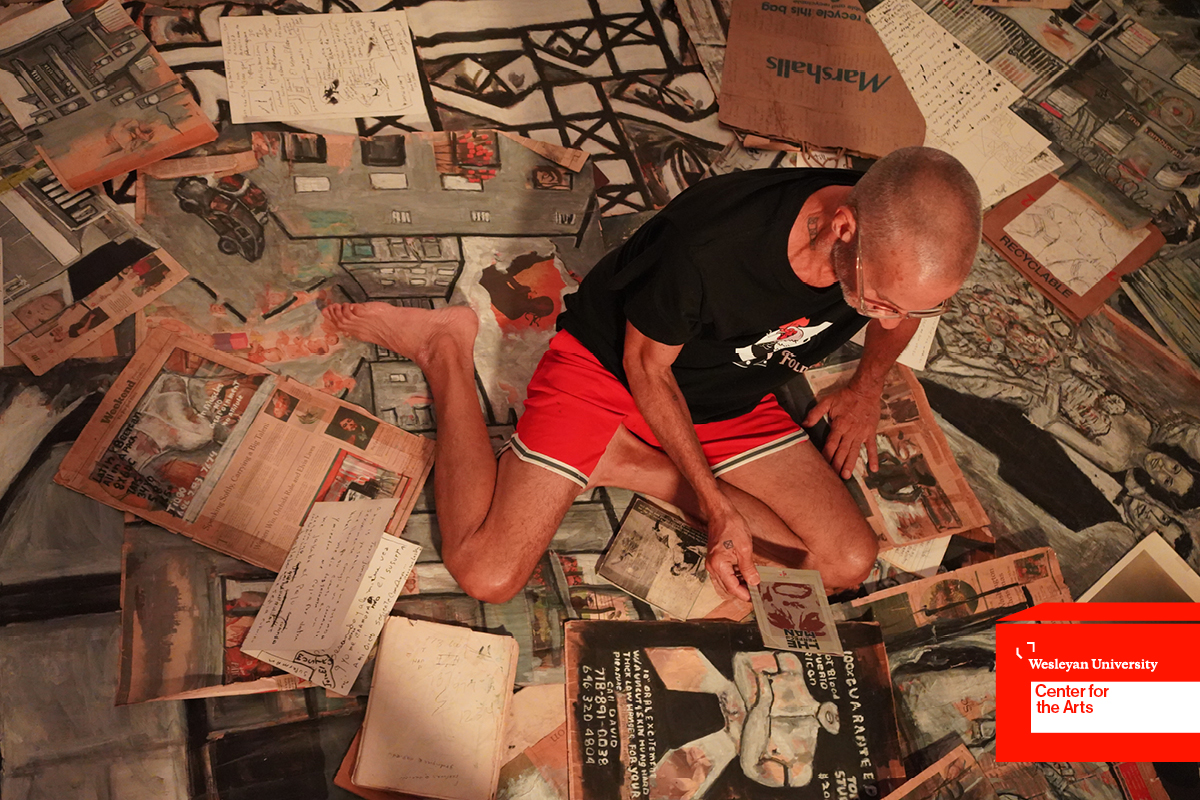
Day With(out) Art 2025: Meet Us Where We’re At
Tuesday, December 2, 2025 at 7:00pm
Ring Family Performing Arts Hall
Free and open to the public
The Center for the Arts is proud to partner with Visual AIDS for Day With(out) Art 2025 by presenting Meet Us Where We’re At, a program of six videos that forefront the experiences of drug users and harm reduction practices as they intersect with the ongoing HIV crisis.
Meet Us Where We’re At speaks not only to the variety of physical locations where contemporary harm reduction is practiced, but also to a broader shift: centering drug users as authors of their own experiences. Rooted in the philosophy of meeting people at their personal reality without judgment, the program affirms the full context of drug use—its pleasures, its risks, and its role in how people survive, care, and connect.
Harm reduction has long been central to the AIDS movement through practices like needle exchange and safe injection sites, and people who use drugs have been affected by HIV since the earliest days of the epidemic. This program brings their perspectives to the forefront. A synopsis of the six commissioned films included in the program is available below.
For this presentation, the Center for the Arts is partnering with two student-led organizations at Wesleyan University, uplifting the work of campus organizing and activism as a one part of the broader network of care, collective response, and world-making practices in the global response to HIV. Students from Wesleyan Harm Reduction Initiative (WesHRI) and Adolescent Sexual Health and Awareness (ASHA) will provide an introduction to the screening and host post-screening breakout discussion groups for attendees. Director of the Center for the Humanities and Professor of Science and Technology Studies, African American Studies, Sociology, and Environmental Studies Anthony Ryan Hatch and Director of the Center for the Arts Joshua Lubin-Levy ’06 will offer introductory remarks and help to facilitate the post-screening conversations.
This event is presented as part of AFTERWORDS: entanglement, a series of public programs sponsored by Wesleyan University’s Center for the Arts (CFA) and the Institute for Curatorial Practice in Performance (ICPP) and co-curated by Joshua Lubin-Levy and ICPP Director Noémie Solomon.
Visual AIDS is a New York-based non-profit that utilizes art to fight AIDS by provoking dialogue, supporting HIV+ artists, and preserving a legacy, because AIDS is not over. For more information on the history of Day With(out) Art visit their website here.
PROGRAM
Kenneth Idongesit Usoro, Voices of Resilience (Nigeria)
Voices of Resilience follows the lives of queer individuals and drug users living with HIV in Nigeria. Through personal interviews and experimental visual storytelling, the film shows the protagonists’ worlds as they seek out underground harm reduction services.
Hoàng Thái Anh, The Sister’s Journey (Vietnam)
Through a documentary style, The Sister’s Journey explores the daily life of a transgender woman in Vietnam using drugs. The film delves into her fear of stigma, struggles she faces, and the vital role of harm reduction services and healthcare available to her.
Gustavo Vinagre and Vinicius Couto, chempassion (Brazil/Portugal)
In the magical realist film, chempassion, a gay man reminisces about his orgy days and chem sex, contemplating what the future holds for himself and his close relationships.
Camilo Tapia Flores, Realce (Highlight) (Brazil/Portugal)
Realce is a documentary short following two HIV-positive friends, DJ Deseo and porn actor Fernando Brutto, during one of their performances at Rio de Janeiro’s Carnival. The duo move through the streets of Rio and Carnival “blocos,” sharing their reflections on friendship, undetectability, their relationship with sex, and drug use within their own community.
Camila Flores-Fernández, Ghost in the Park (Peru/Germany)
Ghost in the Park traces the narratives of the community of Görlitzer Park, an area in Berlin known for public drug use and trade. Highlighting “drug consumption buses” that promote safer use and aim to reduce HIV transmission among drug users, the space of the bus is taken as an axis through which the experiences and feelings of the community around the park are amplified.
José Luis Cortés, ¿Por qué tanto dolor? (Why so much pain?) (Puerto Rico)
Instead of asking, “Why so much meth in the gay community?,” Cortés’s experimental film provokes the deeper question, “Why so much pain?” The film delves into the emotional and social wounds that fuel addiction and risk-taking behaviors.
The artists in this program were selected by a jury of artists/community workers including Eva Dewa Masyitha, Heather Edney, charles ryan long, and Leo Herrera.
Image above: José Luis Cortés, ¿Por qué tanto dolor? (Why So Much Pain?), 2025. Commissioned by Visual AIDS for Meet Us Where We’re At.
Image on upcoming events page: Camilo Tapia Flores, Realce (Highlight), 2025. Commissioned by Visual AIDS for Meet Us Where We’re At.